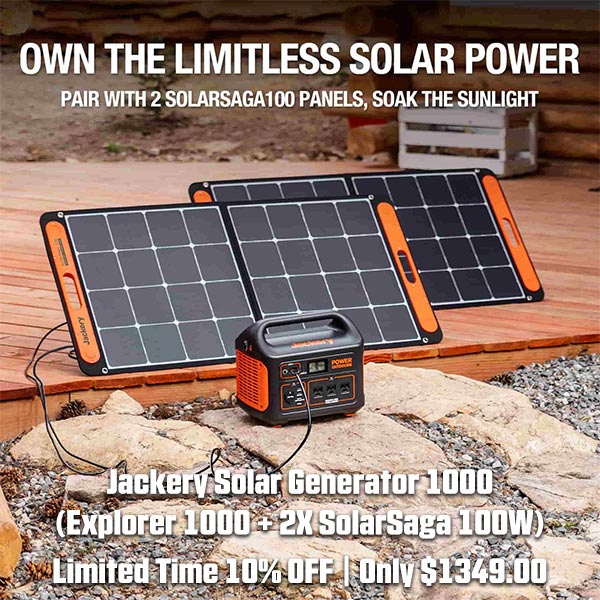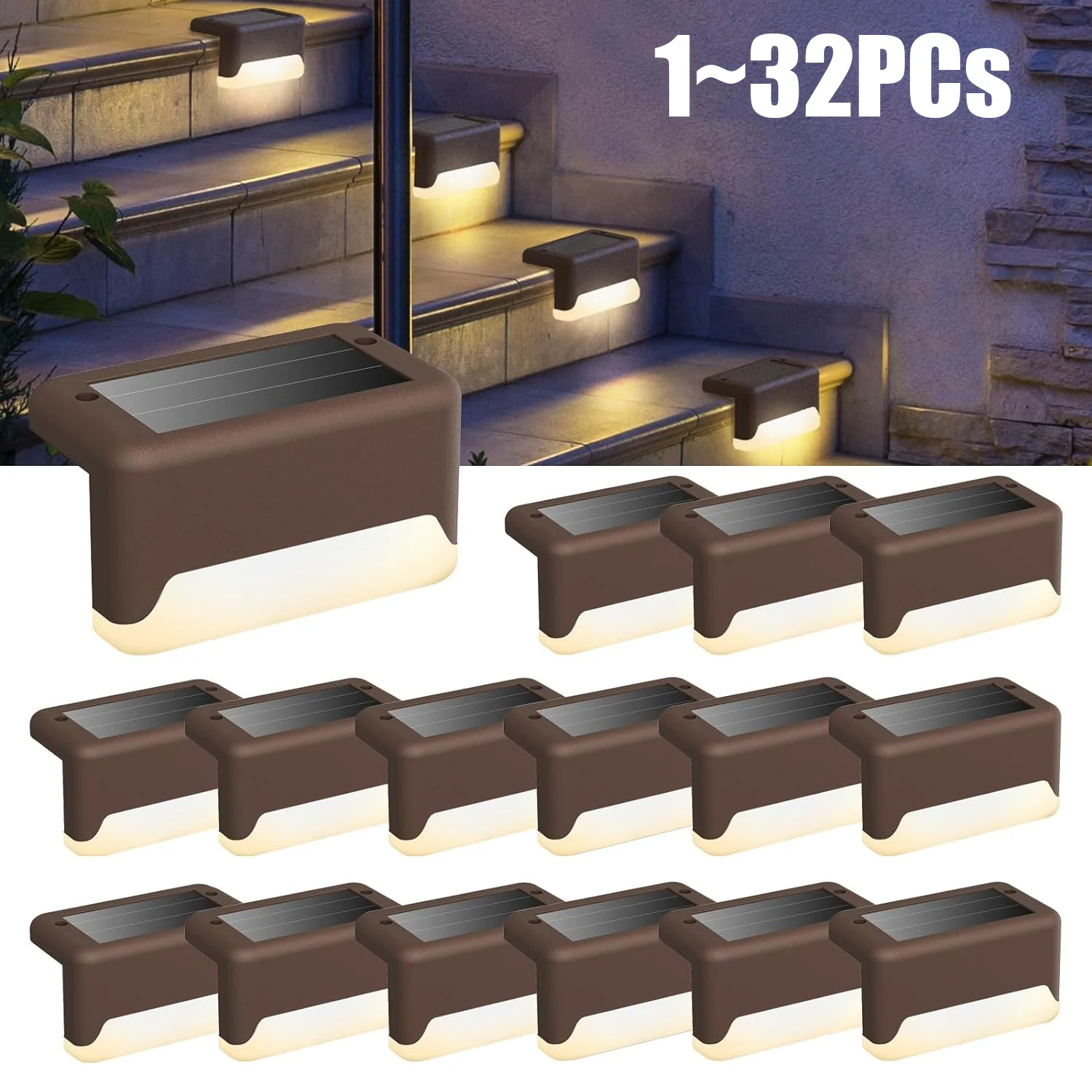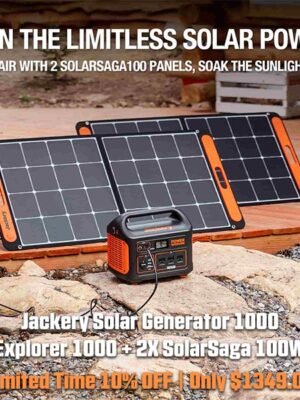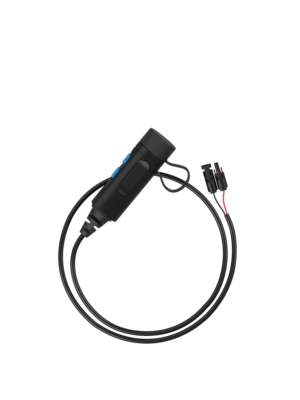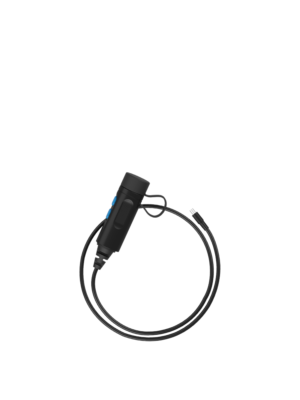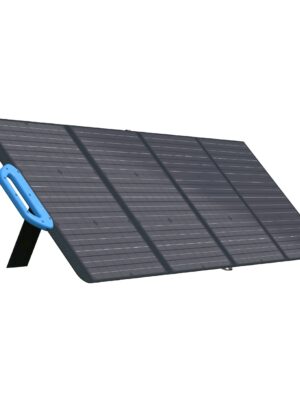7 Essential Qualities For Your Secret Setup
By Just In Case Jack |
Last Updated: February 22, 2023
Are you interested in finding the best bug out location?
If you reply to this question with an enthusiastic:
Hell, Yes, then the way I see it, you have two options.
- Buy a private parcel of bug out land
- Scope out a remote some remote bug out locations
Obviously, option 1 is ideal, but not all of us have a large stash of cash to spend on buying a bug out property.
If you fall into the second category, then it’s time to start scouting out some public survival land options.
Of course, you could always plan to bug in, but you better be fully prepared to defend what’s yours if you live in one of these 146 counties.
Ok, enough with the preamble. Here’s what I’m going to cover in this article.
- What to look for in a “best” bug out property (including a couple of absolute”must-haves”)
- Detailed Instructions On How To Find Bug Out Locations For Sale (with images)
- Detailed Instructions On How To Start A Public Bug Out Location Search (with images)
As A Way To Introduce You To Skilled Survival, We’re Giving Away Our #78 Item Complete Prepper Checklist. Click Here To Get Your FREE Copy Of It.
7 Advanced Tips For Finding An Ideal BOL
One quick word of advice…
Do your research (lots of it). To find the best bug out locations, it’s critical you take your time making the best decision which could mean the difference between surviving or perishing.
So take the time to learn the bug out location essentials that make a good and bad bug out location to avoid making a costly mistake. Here are the essential bug out location ideas to keep in mind.
1. Bug Out Location Distance
There are two primary aspects to figuring your total bug out distance, and they both oppose each other.
- Your entire bug out travel distance
- Your bug out location distance from dense populations.
With your travel distance, you want to keep it as short as possible. The further you must go to reach your bug out location, the more opportunities to run into problems. Depending upon the SHTF event and thinking about worst-case scenarios, roadblocks could be set up within hours.
According to a solid article posted by the SurvivalMom (When Things Go South Or What To Expect When SHTF):
Most major road arteries will be closed and patrolled by law enforcement and National guard elements with orders to stop, search and detain or turn back anyone they find. So, plan your routes well, have at least 3 routes out, and make sure you go for a drive and check them out on a regular basis.
The second aspect is the proximity to high-density populations. I’ll make this one relatively easy for you, don’t pick a bug out location in any of these 146 danger zone counties.
Now that we’ve identified the two primary aspects related to your bug out destination’s distance, let’s discuss these in a bit more detail.
If you’re purchasing a piece of land to serve as a bug out property, then you need to figure out how far that property is from your current home.
Your Travel Distance = The total distance from your current home to your bug out location.
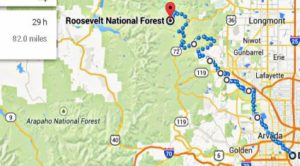
Example Of A Bad Walking Bug Out Route – It’s too long because it would take a week of hiking to reach your destination.
If you are walking, then you need to try to keep it within a five-day total travel distance.
At a max of about 12 miles per day (trust me, that’s a lot), you’re looking at a location that is no more than 60 miles from your takeoff location.
Side Note: Make sure you buy the best bug out bag for this trek you can afford.
Exclusive Bonus Content – Skilled Survival’s 104 Item Bug Out Bag Checklist – the only bug out checklist worth using. Click Here To Get Your FREE Copy Of It.
If you are driving to your bug out location, you should only plan to go as far as a single fuel tank will take you.
If you are planning anything further than that, it’s imperative to get a solid long-term fuel storage plan to refuel without relying on gas stations.
Regardless of how much fuel you have stored, it’s still not advisable to attempt a multi-state travel excursion to your final bug out location.
Traveling that far takes a lot of time (especially if you are avoiding the jammed interstate system), and it adds lots of potential run-ins with unfriendlies along the way.
You need to be able to assess honestly and reply to the following two questions:
- Do you honestly believe you can get from your current location to your bug out location safely during a major crisis?
- Is the bug out location a safe distance from high-density population areas?
If you can confidently answer both of these questions in the affirmative, then that bug out location is one you should investigate further.
If not…move on and keep searching.
 2. Water Availability
2. Water Availability
Ideally, you want to have a natural water source for your bug out property.
Why? Because you can’t survive long without it, why would you choose a property that puts you at direct odds with the most crucial survival resource – WATER?
Unless you have a massive water storage system planned out that is self-replenishing (a.k.a. large storage tanks and rainwater collection systems), you will want a pond, lake, river, or stream nearby.
For those who plan to bug out in the desert, the biggest challenge will be water procurement…if this is you, then you should check out this device that creates water from the air.
For just about everyone else, purchase bug out land with water on it or a constant natural spring.
The most obvious benefit of water is to consume it. However, if water is abundant, it can go way beyond just hydration.
Water is also necessary for sanitation and is great for constant power generation purposes (running water only).
If you have running water that is moving down a slope at a decent speed, then you might be able to harness the energy of the water by setting up a basic hydro-power generation system.
Don’t discount this potential; small hydroelectric setups can run a basic homestead based solely on running water.
So the challenges you must be able to overcome in regards to water on your bug out land are:
- Are there any water resources on (or very near) the property?
- How reliable is this water source? Is it seasonal or available all year? (You don’t want a trickling stream to dry up at the first signs of mild drought.)
Bonus points if the water source has enough kinetic energy to generate power.
3. Keeping Your Bug Out Location Secured and Concealed
Even if you choose a highly remote survival location, far away from high-density cities, unfriendly people may still discover your bug out location if you’re not careful. You found the location, so there’s a good chance other people might also find it someday.
Try to find areas that are not near any obvious paths of travel.
If you are looking for a good bug out location in mountainous terrain, ideally, the location would not be near a mountain pass where people naturally want to travel.
If it’s challenging for you to get to the survival location, then that’s a positive thing for concealment; your odds of someone else stumbling upon your bug out location are much lower.
Once you buy the land and set up a cabin, shelter, RV, or tent of some sort, make certain it blends in with the surroundings so that wanderers can’t see it from a distance.
When you have a fire for heat and food, will the smoke and scent be detectable to other people from miles away? You should probably keep your fires contained and only light them at night to hide the smoke.
According to SurvivalistPrepper:
Even if you live in a semi-rural or rural area the smell of your cooking will carry very far, in some cases more than ½ a mile away.
Also, investigate how easy it will be to watch and defend the bug out property. You don’t want to be in a poor defensive position to protect the land should a group of bandits decide to attack.
To quote a good article from PrepForSHTF on this topic:
Defending your bug-out location or safe haven and possessions during a crisis is new territory for most people, and if you do not have specific training in defense or offense tactics then it is likely you will lose your supplies or even your life if you try to barricade yourself inside and fight it out.
It’s best to try and avoid a conflict in the first place (i.e. concealment).
Now, concealment and water availability can at times be at odds with each other.
People are drawn to water for obvious reasons, and they will either follow rivers and streams or look for ponds.
However, do the best you can and know a property’s strengths and weaknesses to plan accordingly.
4. Self-Reliance Opportunities
I touched on a power generation option earlier, but solar power options should also be investigated if you are searching in a region with reliable amounts of direct sunlight.
Some form of basic grid-independent power generation is a huge bonus for a survival property.
You’ll also want to look for food-producing soil potential surrounding your survival property.
Growing a garden will be challenging if there is no soil and it’s all rock.
Is there firewood available? Abundant firewood will be required to heat your survival location and cook your food.
Can you raise any livestock for food on the property? Is there enough grass to keep goats? Can you grow food to support chickens?
How prevalent is wild game or fish?
All these food considerations add up to either a good survival bug out plan or a nightmare.
5. Land Property Costs
As a realist, the property’s cost will always be an issue.
I wish we could all find a good bug out location for under $3000, but that’s unrealistic.
The honest truth is: The best bug out locations will cost more.
So you’ll have to balance each one of these 7 qualities to find one that will work well within your budget.
However, if your plan is to squat on some remote public land, the property costs aren’t really an issue.
Exclusive Bonus Content – Skilled Survival’s 104 Item Bug Out Bag Checklist – the only bug out checklist worth using. Click Here To Get Your FREE Copy Of It.
6. Government Red Tape For The Land
Double-check any zoning requirements to build structures, grow crops or raise animals.
After SHTF the government might not be following up on your bug out location anymore (they’ll have bigger things to worry about), but until that day comes…they will.
To get your survival location setup before SHTF, you want to avoid having to deal with a lot of red tape. So it’s best to investigate this before you sign on the dotted line.
7. Land Location and Natural Threat Potential
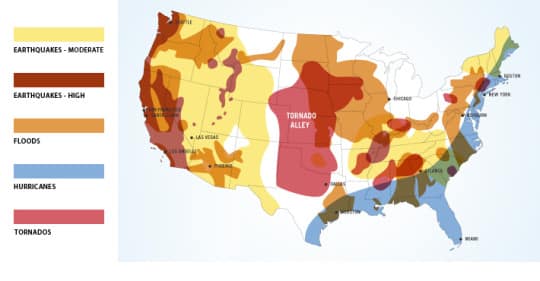
As you can see from this map, there are not many areas in the US where you’re not in a high-risk zone for at least one natural disaster.
You might have found a good bug out location with a large stream running through it, but what’s the possibility of water from that stream flooding your new bug out cabin next spring?
Is the location in tornado alley? Are wildfires a concern?
Take a look at some data based on your proposed location. While this factor alone shouldn’t deter you from purchasing a specific bug out property it should be a consideration.
There may be ways to mitigate the natural threats once you build your shelter.
Maybe you build the structure higher up on the hill than you originally intended to avoid any flooding potential.
You could clear some land surrounding the home to make it a defensible area and have a better chance of surviving a wildfire.
You might build your bug out cabin with better fasteners or keep it lower profile to stand up better against high winds.
Having each of these aspects in mind before, during, and after you purchase your bug out land will go a long way to making your bug out property a success.
Once you have secured your survival property, you must plan how you want your future homestead to operate.
Where To Begin To Find Private Bug Out Locations For Sale
You can find bug out location ideas online.
Start with a couple of rural land websites. You can filter your search by area, type of land, and price.
Let’s go through an example, shall we…
For shits and grins, let’s say I live in the metro Atlanta area (I don’t 🙂)
First, I would start looking for the most sparsely populated counties in Georgia. You can use US-places.com. Select the “state-to-state and county-to-county comparisons of population” option.
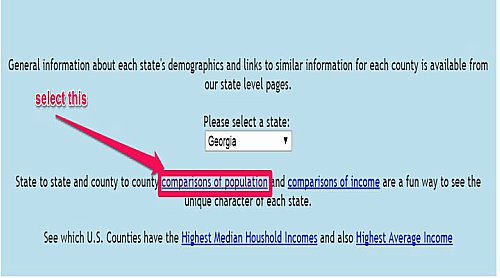
Find Georgia and click it.
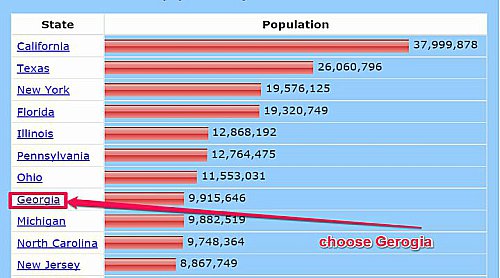
Looks like the least populated county in Georgia is Taliaferro County (this is based solely on absolute population – make sure to consider density, too which is absolute population divided by square miles).

Now I have no actual experience in this area, and it might not be the best selection ever, but I see that Taliaferro is a county located between Atlanta and Augusta.
So it might not be “ideal” as this is somewhat near a major interstate, but this is as good a place to start your search as any.
The bug out location distance is about 95 miles from the heart of Atlanta, so it might be a bit out of reach for a hiking bug out unless you live significantly East of Atlanta.
In this case, a good bug out vehicle is recommended.
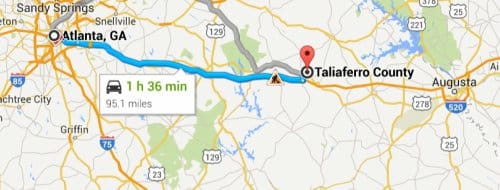
So let’s roll with it and see what we find.
Enter Taliaferro County into one of the three rural land websites and hit the big red search button.
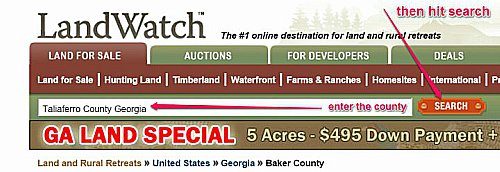
Now scroll through the results until you find something worth exploring further.
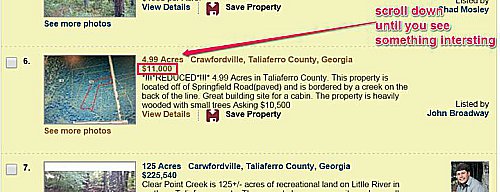
This bug out property seems to have some potential. It’s a price that some people might be able to afford. It’s 5 acres, providing some defensible space to work with.
It sounds like there’s water potential with a creek bordering the rear of the property.
If coughing up 11k seems like a pipe dream, then maybe you can team up. One often overlooked aspect of survival is creating a trustworthy survival coalition.
Maybe you have some extended family or close friends who are also preppers. Maybe they would jump at the chance of teaming up to purchase a good bug out property together.
You could build several small cabins on a 5-acre parcel of land.
If you found one family member and a couple of friends, you might get access to this property for only $2,750. Yes…that’s still not free, but it looks much more affordable when you team up.
Plus, if you team up with a group of like-minded friends, you’ll all have higher survival rates when SHTF.
That’s how I would start my search for a private bug out location to purchase. I would do this several times and come up with a list of several properties to visit.
Never, ever buy a property sight unseen. I’ve heard of people doing this when they find a great deal online, which typically results in major disappointment.
Find a buyer’s real estate agent you trust and go see the properties with your own eyes.
Another place I’ve seen some interesting bug out property listings is Craigslist. I saw a potential bug out property about a month ago selling for 5k in a remote location in Colorado.
Now again, buyer beware…most times, these lower-priced survival locations are priced that way for a reason.
It’s your job to find out why the bug out location price is reduced and then determine whether that’s a deal-breaker or not.
Exclusive Bonus Content – Skilled Survival’s 104 Item Bug Out Bag Checklist – the only bug out checklist worth using. Click Here To Get Your FREE Copy Of It.
Where To Begin To Find Public Bug Out Land Options
Maps.
I always start with maps. I love topographical maps.
Get some topo maps of the remote government lands that surround you.
My favorite topographical maps are National Geographics Trails Illustrated Series. They are the right size, have the right amount of detail, and are waterproof.
I highly recommend buying one for your bug out location area.
Side Note: I like National Forests more. I’d avoid National Parks. National parks are too busy and have too many full-time park rangers constantly patrolling the backcountry.
Topo maps provide crucial terrain detail. They are necessary to hunt for a worthy bug out location. I look for remote areas with as many of the 7 bug out location essentials I described above.
The good news is…you can begin this search online with Free Online Topo Maps.
http://www.digital-
If you visit this website, here’s what you’ll find.
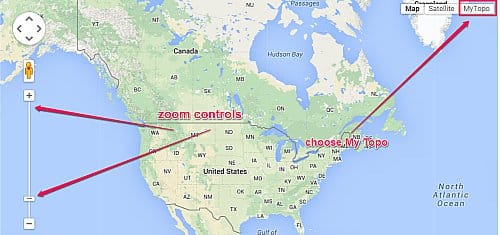
You have zoom controls on your left, and make sure to pick “My Topo” in the upper right-hand corner.
Let’s say we are looking for some land in Northern Georgia (Chattahoochee National Forest); here’s what a topographical map of this area looks like.
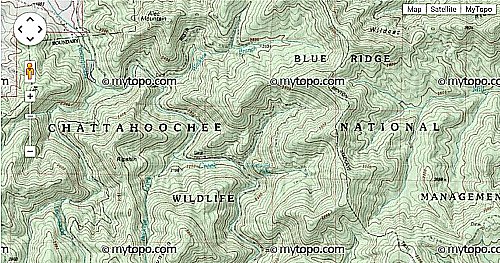
I focus on areas with water nearby, but getting to it is also a pain. Some rough service roads might be nearby, but I’d avoid anything near a paved highway.
Mark up some potential survival locations and then schedule some time to visit them. Plan some overnight camping trips to these remote locations to scope them out.
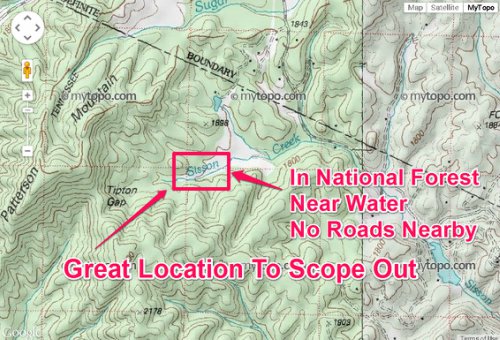
Once you find a decent, free bug out location, you can begin forming the rest of your bug out plan. Figuring out such details as your overall bug out location distance, caching, shelter, homesteading, etc.
If you have an RV or camper, that might work if you can drive to the location.
Otherwise, you might need to start stocking supplies (caching) in your new bug out location (hide it well).
Also, make certain your bug out bag, bug out bag checklist, and bug out plan are 100% ready to go.
Exclusive Bonus Content – Skilled Survival’s 104 Item Bug Out Bag Checklist – the only bug out checklist worth using. Click Here To Get Your FREE Copy Of It.
What do you think? Was this helpful? Did I miss anything you think I should add to help find a good bug out location?
I’d appreciate any feedback you might have in the comments below.
Prepare, Adapt and Overcome,
“Just In Case” Jack
P.s. Are you ready for the tough times ahead?
Find out now by taking my short Readiness Score Quiz – it’s absolutely free.
Once complete, you’ll know exactly where you stand on the “fragile” vs.” resilient” spectrum.
So click here to start the Quiz….And don’t worry; the questions are so easy a 3rd grader could answer them.

Click on the image to begin the Quiz and find out once and for all if you’re part of “The Fragile Masses” or “The Resilient Few.”

Get My 10 Steps To Basic Preparedness Video For FREE.
Plus daily survival tips (unsubscribe anytime).
Recommended Reading
Please Support Our Sponsors
Solar Power Generator Discounts Along With Free Shipping
- 10% OFF for Jackery Solar Generator 2000 Pro Series with code "JADEAL"
- 10% OFF for Jackery SolarSaga 200W Solar Panel with code "JADEAL"
- 10% OFF for Jackery Solar Generator 1500 Series with code "JADEAL"
- 10% OFF for Jackery Solar Generator 1000 Series with code "JADEAL"
- 10% OFF for Jackery Explorer 1500 Portable Power Station with code "JADEAL"
- 10% OFF for Jackery Explorer 1000 Pro Portable Power Station with code "JADEAL"
- 10% OFF for Jackery Explorer 500 Pro Portable Power Station with code "JADEAL"
- 10% OFF for Jackery Explorer 300 Pro Portable Power Station with code "JADEAL"
- 10% OFF for Jackery SolarSaga 100W Solar Panel with code "JADEAL"

The University of Georgia is represented by the Georgia Bulldogs . The Bulldogs participate in the Southeastern Conference's (SEC) Eastern Division of the NCAA.
They play their home games in the storied Sanford Stadium in Athens, Georgia. The first season in Georgia was in 1892. In 1942, 1980, and 2021, the Georgia Bulldogs won three national championships.
The Georgia Bulldogs have additionally been crowned the National Champion in four additional seasons by at least one polling organization (1920, 1927, 1946 and 1968).
The Georgia Bulldogs are tied for second place in conference history with their 15 conference titles, including 13 SEC titles, and their 59 bowl appearances, which ranks second all-time.
In addition, the program has produced five top picks in the National Football League (NFL) draft, two Heisman Trophy winners, numerous winners of various national honors, and many others.

Longhorns football represents the University of Texas in Austin often known as Texas, UT or the Texas Longhorns. The Longhorns represent the Big 12 Conference in the NCAA Division. They play in Austin, Texas, at the Darrell K. Royal-Texas Memorial Stadium.
The Texas Longhorns are ranked third and seventh, respectively, in terms of all-time wins and win-loss records, with over 900 victories and an overall win-loss percentage of.705.
The legendary program also boasts four national titles, 32 conference titles, 100 First Team All-Americans, and two Heisman Trophy winners.
Get your Texas Longhorns Revival T-Shirt today. The Texas Longhorns Rustic Revival shirt is also a fan favorite.
Many college sports fans like to wear their gear all around town, get your Texas Longhorns Centered gear and show your support.




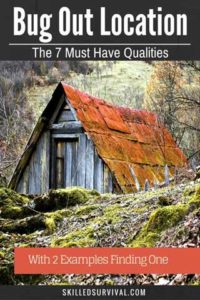
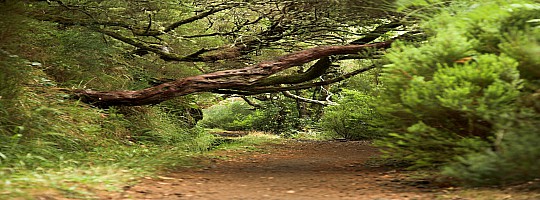
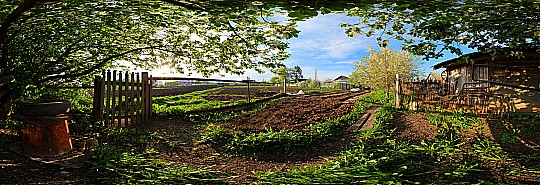


 Gettr
Gettr